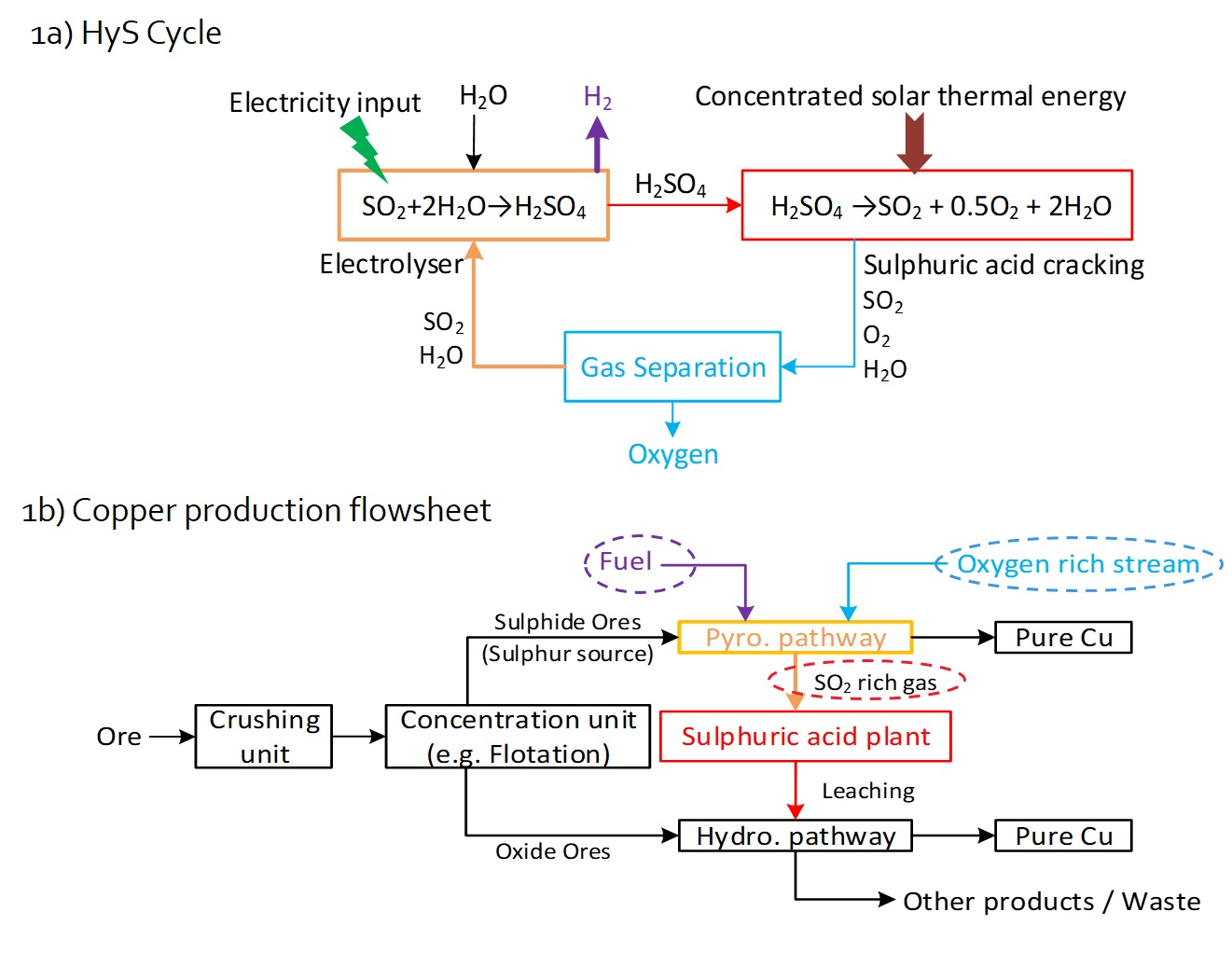(511g) Opportunities to Enhance Sustainability of Copper Production with the Hys Cycle
AIChE Annual Meeting
2020
2020 Virtual AIChE Annual Meeting
Sustainable Engineering Forum
Symposium on Solar Power and Chemical Systems in Honor of Prof. Aldo Steinfeld V
Wednesday, November 18, 2020 - 9:45am to 10:00am
The HyS cycle, initially developed by the Westinghouse Electric Corp for H2 and O2 production through the splitting of water from nuclear heat source [2], has been found to offer strong potential for low-cost H2 production. The cycle was then further developed by the German Aerospace Centre (DLR) using solar thermal energy [3]. The HyS cycle was estimated to achieve a solar to hydrogen efficiency of 30%, which is almost twice that of the commercially available PV-electrolysis route [3-4].
This work has been undertaken through the Australian Solar Thermal Research Institute (ASTRI) using Aspen Plus. Figure 1 presents schematic diagrams of the HyS cycle and the copper production process. As shown in Figure 1(a), the HyS cycle is a chemical looping process with sulphuric acid as one of the circulated components. In the first reactor, sulphuric acid is thermally decomposed at temperatures of 600-1200 °C, and a mixture of O2, SO2 and H2O in the gas phase is produced. Gaseous SO2, after separation from oxygen, is sent to the second reactor, where, it is electrolysed with water to produce H2 and H2SO4. The hydrogen product leaves the cycle while the sulphuric acid is returned to the first reactor to complete the loop.
As shown in Figure 1(b), the copper production process, comprises two main pathways, which depend on the composition of the mineral feedstock, as follows:
- Pyrometallurgy, in which the minerals are heated reacting sulphide ores with oxygen-enriched air to produce copper and SO2 gas in a series of pyro-furnaces (smelters, converters and fire refiners). The oxygen is typically provided at present using air separation units (ASU).
- Hydrometallurgy, in which the oxide ores are chemically treated to produce pure copper. Since the hydrometallurgy process requires sulphuric acid, usually the sulphur dioxide from the pyro-pathway is sent to the sulphuric acid plant. The sulphuric acid product is then utilised to dissolve the copper-containing ores for subsequent precipitation in electrowinning cells.
The sulphur dioxide product from the copper pyrometallurgy process has potential to feed into the HyS cycle to generate sulphuric acid to be utilised in hydro-pathway while the H2 and O2 products from the HyS cycle have potential to be used in the copper pyro-pathway to displace ASU and/or fossil fuels. The potential of this linkages will be reported in the paper through the following scenarios:
- the HyS cycle is scaled to produce enough hydrogen for the pyro-furnaces;
- the HyS cycle is sized to meet the oxygen demands in the pyro-pathways; and
- the HyS cycle is sized based on the production rate of the SO2 from the furnaces. In this scenario, the sulphuric acid would be supplied from the HyS cycle rather than the acid plant with any excess acid being used in the hydrometallurgy pathway or sold as a product.
Figure 1 (Caption): Schematic representation of a) HyS cycle b) Copper production flowsheet. HyS cycle produces hydrogen (fuel), oxygen and sulphuric acid that can be used in the copper production process.
References
- National Greenhouse and Energy Reporting Data (NGER) website, accessed: 28.04.2020. http://www.cleanenergyregulator.gov.au/NGER/National%20greenhouse%20and%20energy%20reporting%20data/Data-highlights/2018-19-published-data-highlights
- Brecher L.E. and Christopher K.W., “Electrolytic decomposition of waterâ€, Westinghouse Electric Corp., Patent 3,888,750, June 10, 1975.
- Niehoff, A. G., Botero, N. B., Acharya, A., Thomey, D., Roeb, M., Sattler, C., & Pitz-Paal, R. (2015). Process modelling and heat management of the solar hybrid sulfur cycle. International Journal of Hydrogen Energy, 40(13), 4461-4473.
- Thomey, D., de Oliveira, L., Säck, J. P., Roeb, M., & Sattler, C. (2012). Development and test of a solar reactor for decomposition of sulphuric acid in thermochemical hydrogen production. International journal of hydrogen energy, 37(21), 16615-16622.
Checkout
This paper has an Extended Abstract file available; you must purchase the conference proceedings to access it.
Do you already own this?
Log In for instructions on accessing this content.
Pricing
Individuals
| AIChE Pro Members | $150.00 |
| AIChE Emeritus Members | $105.00 |
| AIChE Graduate Student Members | Free |
| AIChE Undergraduate Student Members | Free |
| AIChE Explorer Members | $225.00 |
| Non-Members | $225.00 |

